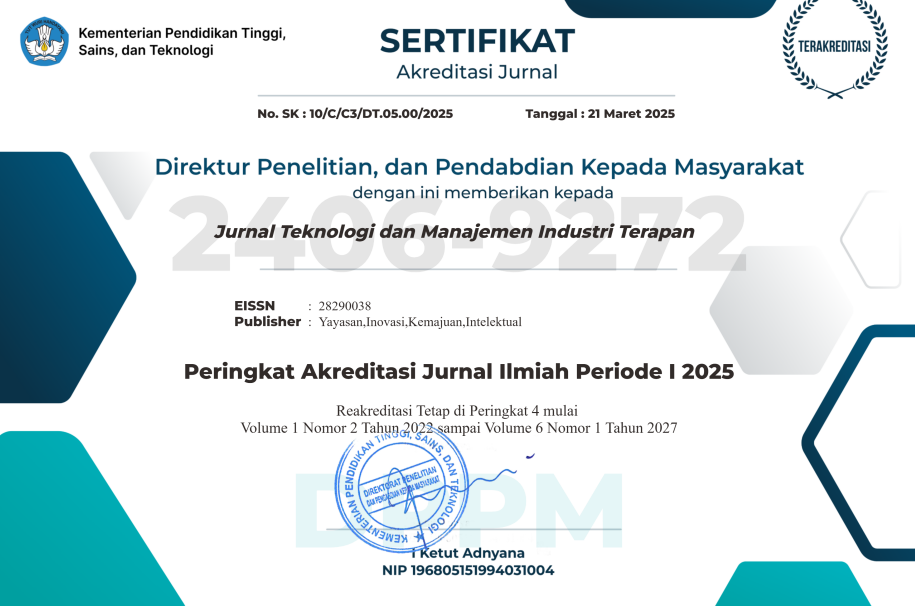Desain User Experience (UX) Pada Website Smart City untuk Meningkatkan Aksesibilitas Layanan Publik
DOI:
https://doi.org/10.55826/jtmit.v4i2.582Keywords:
User Experience, Smart City, Digital Accessibility, Government Website, Public ServicesAbstract
Perkembangan konsep smart city menuntut pemerintah untuk menyediakan layanan publik yang tidak hanya efisien dan terintegrasi, tetapi juga inklusif dan mudah diakses oleh seluruh lapisan masyarakat. Penelitian ini bertujuan merancang dan mengevaluasi desain user experience (UX) pada website smart city guna meningkatkan aksesibilitas digital, khususnya bagi kelompok rentan seperti penyandang disabilitas dan lansia. Pendekatan Human-Centered Design (HCD) dan standar Web Content Accessibility Guidelines (WCAG 2.1) diintegrasikan dalam proses perancangan. Metode penelitian meliputi observasi, studi literatur, wawancara, penyebaran kuesioner, serta evaluasi heuristik dan usability testing terhadap prototipe website. Hasil pengujian menggunakan System Usability Scale (SUS) menunjukkan skor rata-rata 86,4 (kategori “Excellent”), dengan mayoritas pengguna dapat mengakses fitur utama dalam waktu kurang dari dua menit. Elemen UX seperti navigasi intuitif, kontras warna tinggi, kompatibilitas screen reader, dan desain responsif terbukti meningkatkan kenyamanan dan efektivitas interaksi pengguna. Penelitian ini memberikan kontribusi praktis dan teoretis dalam pengembangan website smart city yang inklusif dan berorientasi pada pengguna, serta mendorong transformasi digital layanan publik yang berkelanjutan.
References
H. W.Alomari, “A User Interface (UI) and User eXperience (UX) evaluation framework for cyberlearning environments in computer science and software engineering education,” Heliyon, vol. 6, no. 5, 2020, doi: 10.1016/j.heliyon.2020.e03917.
L.Luther, “User experience (UX) in business, management, and psychology: A bibliometric mapping of the current state of research,” Multimodal Technol. Interact., vol. 4, no. 2, 2020, doi: 10.3390/mti4020018.
W. (.Albert, Measuring the User Experience: Collecting, Analyzing, and Presenting UX Metrics. 2022. doi: 10.1016/C2018-0-00693-3.
L.Fitra, H.Tolle, andH. M.Az-Zahra, “Perancangan User Experience Aplikasi Portal Smart City Kota Malang dengan Metode Pendekatan Human-Centered Design,” J. Pengemb. Teknol. Inf. dan Ilmu Komput., vol. 5, no. 2, pp. 835–844, 2021.
Å.Stige, “Artificial intelligence (AI) for user experience (UX) design: a systematic literature review and future research agenda,” Inf. Technol. People, vol. 37, no. 6, pp. 2324–2352, 2024, doi: 10.1108/ITP-07-2022-0519.
T.Zaki, “Neurological and physiological measures to evaluate the usability and user-experience (UX) of information systems: A systematic literature review,” Computer Science Review, vol. 40. 2021. doi: 10.1016/j.cosrev.2021.100375.
Y.Son, “Development of methodology for classification of user experience (UX) in online customer review,” J. Retail. Consum. Serv., vol. 71, 2023, doi: 10.1016/j.jretconser.2022.103210.
A.Abella, M.Ortiz-de-Urbina-Criado, andC.De-Pablos-Heredero, “A methodology to design and redesign services in smart cities based on the citizen experience,” Inf. Polity, vol. 24, no. 2, pp. 183–197, 2019.
A.Al-Hunaiyyan, “Student Information System: Investigating User Experience (UX),” Int. J. Adv. Comput. Sci. Appl., vol. 12, no. 2, pp. 80–87, 2021, doi: 10.14569/IJACSA.2021.0120210.
B.Richardson, “Mobile Application User Experience Checklist: A Tool to Assess Attention to Core UX Principles,” Int. J. Hum. Comput. Interact., vol. 37, no. 13, pp. 1283–1290, 2021, doi: 10.1080/10447318.2021.1876361.
H. B.Santoso, “The use of User Experience Questionnaire Plus (UEQ+) for cross-cultural UX research: evaluating Zoom and Learn Quran Tajwid as online learning tools,” Heliyon, vol. 8, no. 11, 2022, doi: 10.1016/j.heliyon.2022.e11748.
A. K.Darmawan, D. O.Siahaan, T. D.Susanto, B. A.Umam, andB.Bakir, “User Interface and Usability Assessment of mobile-based Smart City using Webqual 4.0 Approach: an insight of Madura Island Districts,” in 2020 6th International Conference on Science and Technology (ICST), IEEE, 2020, pp. 1–6.
E.Ubam, “User Interface/User Experience (UI/UX) Analysis Design of Mobile Banking App for Senior Citizens: A Case Study in Sarawak, Malaysia,” Proceedings of the International Conference on Electrical Engineering and Informatics. 2021. doi: 10.1109/ICEEI52609.2021.9611136.
R.Gunawan, “The Effect of Design User Interface (UI) E-Commerce on User Experience (UX),” Proceedings of 2021 6th International Conference on New Media Studies, CONMEDIA 2021. pp. 95–98, 2021. doi: 10.1109/CONMEDIA53104.2021.9617199.
J.Branch, “Do User Experience (UX) Design Courses Meet Industry’s Needs? Analysing UX Degrees and Job Adverts,” Des. J., vol. 24, no. 4, pp. 1–22, 2021, doi: 10.1080/14606925.2021.1930935.
F. H.Lermen, “Does maturity level influence the use of Agile UX methods by digital startups? Evaluating design thinking, lean startup, and lean user experience,” Inf. Softw. Technol., vol. 154, 2023, doi: 10.1016/j.infsof.2022.107107.
D.Zhu, “Building a Three-Level User Experience (UX) Measurement Framework for Mobile Banking Applications in a Chinese Context: An Analytic Hierarchy Process (AHP) Analysis,” Multimodal Technol. Interact., vol. 6, no. 9, 2022, doi: 10.3390/mti6090083.
R. M.Gilbert, “Reimagining digital healthcare with a patient-centric approach: The role of user experience (UX) research,” Frontiers in Digital Health, vol. 4. 2022. doi: 10.3389/fdgth.2022.899976.
R. D.Prakasa, S. H.Wijoyo, andI. S. E.Maghfiroh, “Evaluasi dan Perbaikan Desain Pengalaman Pengguna Aplikasi Pelayanan Publik Smart Kampung Kabupaten Banyuwangi menggunakan Pendekatan Human Centered Design,” J. Pengemb. Teknol. Inf. Dan Ilmu Komput., vol. 7, no. 2, pp. 727–736, 2023.
N. S. S.Sugiana, “Human-Centered Design in UI/UX for E-Promotion in Indonesia’s Smart Cities: Empowering Culinary Tourism with AI,” 2024 Asian Conference on Communication and Networks, ASIANComNet 2024. 2024. doi: 10.1109/ASIANComNet63184.2024.10811045.
S.Zhou, E. T.Loiacono, andN.Kordzadeh, “Smart cities for people with disabilities: a systematic literature review and future research directions,” Eur. J. Inf. Syst., vol. 33, no. 6, pp. 845–862, 2024.
J.Choma, “UX evaluation of IoT-based applications for Smart Cities: a rapid systematic review,” 27th Ibero-American Conference on Software Engineering, CIbSE 2024. pp. 136–150, 2024. doi: 10.5753/cibse.2024.28444.
E.Fernández-Díaz, C.Jambrino-Maldonado, P. P.Iglesias-Sánchez, andC.delas Heras-Pedrosa, “Digital accessibility of smart cities-tourism for all and reducing inequalities: tourism agenda 2030,” Tour. Rev., vol. 78, no. 2, pp. 361–380, 2023.
A.Chakir, J. F.Andry, R.Bansal, A.Ulah, O.Durrah, andR.Mamoon, “Using Big Data and Artificial Intelligence to Enhance Smart Cities,” in Leveraging ChatGPT and Artificial Intelligence for Effective Customer Engagement, IGI Global Scientific Publishing, 2024, pp. 214–232.
G.Henry andI. G. N.Suryantara, “Analisa Dan Perancangan Sistem Informasi Rekam Medik Pada Klinik Drg Lily Sunaryo,” J. Teknol. Inf., vol. 10, no. 1, 2017.
Y. M.Geasela andJ. F.Andry, “Analisis user interface terhadap website berbasis e-learning dengan metode Heuristic Evaluation,” J. Inform., vol. 5, no. 2, pp. 270–277, 2018.
A.Sala, M.Arrue, J. E.Pérez, S. M.Espín-Tello, andL.Moreno, “Accessibility design issues beyond the standards of government e-services for people with low vision,” Int. J. Human–Computer Interact., vol. 40, no. 19, pp. 5827–5844, 2024.
Downloads
Published
Issue
Section
License
Copyright (c) 2025 Agustinus Fritz Wijaya, Teady Matius Surya Mulyana, Garren Janico Liunard

This work is licensed under a Creative Commons Attribution-NonCommercial-ShareAlike 4.0 International License.


















